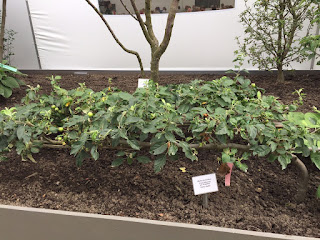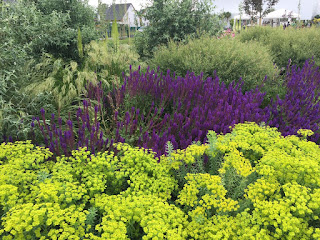 |
| Hanging Around - Bird's Nest Ferns looking at home. |
As you have probably have figured out by now I have an affection for plants. There are many reasons why I do but the biggest reason is simply because they are so gosh darn interesting. In this episode of "Quirky Plant Tales" we look at a group of plants that do things a little differently, not quite independent, they use the support of other plants to help them grow. It's the way they survive that makes them worthy of a blog entry.
There is a group of plants that have evolved to grow on the surface of other plants. Known as Epiphytes, they have developed mechanisms that allow them to take up their water and nutrient requirements through plant tissue (i.e. foliage and aerial roots), thus not relying on root systems for anchoring themselves, but instead getting a leg up via the support from other plants. Their reliance on others for physical support generally doesn't have a negative effect on the plants that help their growth.
Epiphytes have a fairly wide distribution across the earth. They mainly occur in tropical and temperate zones around the world and also in some pretty harsh environments, including the desert, making them a pretty popular choice for gardeners both indoors and outdoors because of their low soil and water requirements.
Epiphytes play a pretty important role in the ecosystem by cycling nutrients through the debris (leaf littler) they collect, breaking it down and returning to the earth. They also provide habitat for many species of animals, reptiles, frogs, fungi & bacteria. Some well know examples of commonly cultivated epiphytic plants include:
Bromeliads:
 |
| Plants that the cling together... |
Probably one of the most common epiphytic plants in cultivation, the Bromeliaceae family consists of almost 3,500 know species, not to mention the dozens of varieties and hybrids. They are famous for being tough and reliable in a variety of locations across the globe. The come in many shapes and sizes, with striking colours through foliage and flowers, which can be very intricate. Possibly the most famous member of the bromeliad family is the sweet and tasty Pineapple.
 |
| The pineapple (Ananas comosus) fruit develops on the top of the 'mother' plant - you can grow new plants from the spiky top of the pineapple fruit. |
Bromeliads are usually grown commercially in very open, coarse soil mixes or bark (similar to what Orchids are grown in) as they are less reliant on a "traditional" root system for getting their food and water. Traditional ways to grow/display bromeliads is similar to how they grow in the wild, on branch axis's in trees or arranged in rocky crevices. They can be held in place by fishing line, a fine rope or string. Nowadays there are many creative ways to display bromeliads - on rocks, on fallen branches or in terrarium or green wall systems.
There is also a group of bromeliads know as "Air Plants". Tillandsia species number over 600 worldwide, growing in tropical forests, mountains and swamps. They are easy care plants that can be glued onto surfaces such as rocks and drift wood, while species like Spanish Moss (or Old Man's Beard) are know as aerophytes, growing with no root structure, they can be bought in pieces which you just hang in tree branches.
These plants have become increasingly popular for indoor use being able to be displayed in interesting ways such as on rocks and crystals, but also in ways mentioned above. Although readily available through retail nurseries and markets, it's not all that difficult to do yourself at home.
 |
| Life on the rocks - one of the many ways you can buy or display an Air Plant |
 |
| "Is it a bird? Is it a plane?" No it's an aerophyte - Spanish Moss or Old Man's Beard to be exact. |
Both rely heavily on the air and atmosphere to provide them with water and nutrients. In the home garden it is a good idea to mist them with a spray bottle or hose periodically. The same goes with fertilizing, use half (or less) strength houseplant liquid feed and apply by spraying in the air around the plant. To determine where they should be placed, a good tip is this - thin leaved species prefer shelter and shaded situations, whereas broad leaf species can handle the elements and exposure better.
Ferns:
We generally think of ferns growing on forest floors amongst the under growth, but as we look at the ground trying to spy these ancient plants we miss the regal species sitting above us. In a previous blog "Lyres & Figs" I mentioned the awesome site of Bird's Nest Ferns (Asplenium nidus or A. australasicum) nestled in trees many feet above us while walking in Minamurra Rainforest. They are a fascinating sight and well worth craning your neck up to spot these beauties.
You will also see these ferns growing on the ground, if you do, take a peek into the centre of the plant and take a look at the amount of leaf litter these ferns can collect. It helps give the picture of how they get their common name, but this collection of fallen leaves and debris actually helps feed the plant and add to the soil bio-mass over time.
Another couple of popular epiphytic ferns in the landscape are know as Stag or Elkhorns.
 |
| Staghorn - Platycerium superbum |
 |
| Elkhorn - Platycerium bifurcatum |
These majestic plants have been popular in cultivation and have been displayed in Aussie gardens for decades. These iconic ferns produce two types of fronds, or fern leaves. One that "laminates" around the surface it is occupying while protecting the roots within from damage. The other fronds are the more obvious ones you see on display, which their common name is derived from.
The main way to tell the two apart are by the way the fronds are arranged. Staghorns have a central broad, solitary frond whereas the Elkhorns are a cluster of smaller fronds, generally with more divided "leaf" ends.
As new fronds are produced the older ones die back and add to the nutrient cycle of the plant - this gives the plant a nest like appearance, this "nest" also catches falling leaf litter, eventually feeding the plant. Many seasoned gardeners will give you the helpful tip of feeding your staghorn banana peels but keep in mind they aren't generally hungry plants, so feed in moderation.
Due to their size and growth habit, Staghorns are predominately sold on boards or shields (plastic or wooden) which makes it easy to attach to a wall or tree trunk. Elkhorns can be grown in pots, which can be transplanted onto a tree or similar surface and held on with the use of sphagnum moss and fishing line or string. It is important to keep them both in a protected spot, out of the elements, somewhere cool, with good air flow and access to moisture - just like what they receive in nature.
Orchids:
This group of plants are some of the prettiest flowering plants in the world and probably the most popular form of epiphytic plant. With over 28,000 species, it is the second largest family of flowering plants behind the daisy family (Asteracea). Around half of the total species of orchid in the world are ephipyhtes.
 |
| Art imitating life - Dendrobium kingianium attached to a piece of driftwood. |
In Australia we have approximately 1,700 native species and around 14% of those are epiphytes. One of the more popular species is Dendrobium kingianum (Pink Rock Orchid), it is one Dendrobium species of around 1,400 in the Asia/Pacific region (including Australia). It is widely grown commercially due to it's robust nature, it is sold both in pots or attached to boards/shields. Modern breeding and hybridisation techniques have further increased it's popularity, producing bigger flowers and more vibrant colours.
In the wild it can grow two ways, as an epiphyte or a lithophyte (growing on rocks). Flowering late winter to spring, the natural colour is predominantly pink but white forms also occur. If growing in pots, a specific orchid barks are available, like with ferns, Dendrobiums generally prefer similar conditions they receive in the wild - shaded, filtered light and protection from hot dry winds.
The other notable species is the Cooktown Orchid - Dendrobium bigibbum or D. phalaenopsis or is it Vappodes phalaenopsis??? The debate over the correct classification of the Cooktown Orchid has done little to overshadow it's striking beauty. Named after the northern Queensland town of Cooktown, where it's natural but limited distribution occurs.
 |
| He's not heavy, he's my brother - Hitching a ride of a Frangipani |
Since it's declaration as state floral emblem of Queensland in 1959, the Cooktown Orchid has become more widely cultivated, needing less protection than similar species, it's more robust nature has made it a popular choice for gardeners in warmer parts of Australia. As with the Rock Orchid previously, it can be grown in pots in specific orchid bark or attached to a tree branches for a more natural look.
Unfortunately due to it popularity, extensive and sometimes indiscriminate collecting in the wild has seen this species listed as 'Vulnerable' on the Environmental Protection and Biodiversity Security Act 1999 as it has become rare or extinct in some of it's natural range.
Several of the epiphytic plants mentioned previously, Bromeliads and Ferns, make great habitat for lizards, amphibians and insects. So if you are into promoting biodiversity and attracting beneficial critters to your garden it's well worth adding a few of these plants to your landscape. They can be used in eye catching and interesting ways in the garden, home or office.
With little effort and outlay (if you're prepared to a little work yourself) you can create plant masterpieces for your home, inside and out. Many of the plant types mentioned above are readily available and there is loads of info on how to care for them out there, especially through various plant groups and societies that are more than happy to help you on your way.
I'll end this episode here, but stay tuned next time when we delve into the world of parasitic plants! Species that reply on other plants for more than just support and are sometimes plain scary when you find out how they use others for their own gain.
























